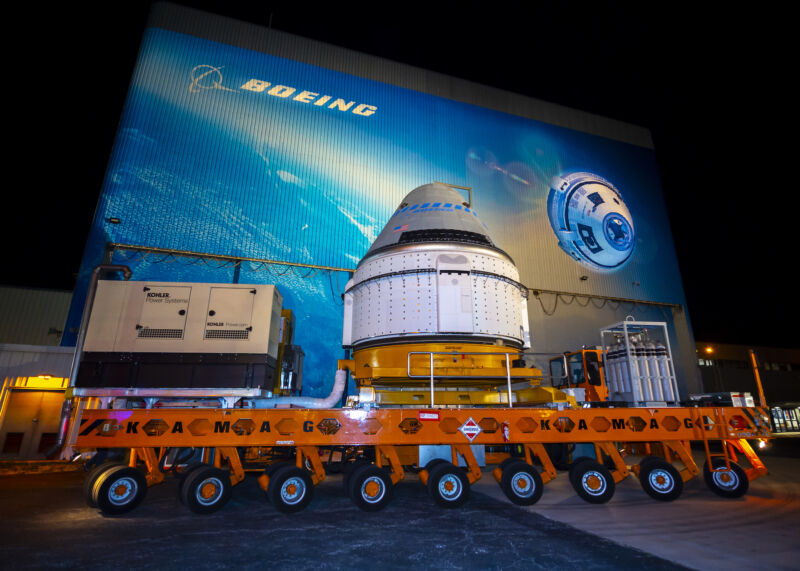
Boeing announced another financial charge Wednesday for its troubled Starliner commercial crew program, bringing the company’s total losses on Starliner to $1.6 billion.
In its quarterly earnings report, Boeing registered a $125 million loss on the Starliner program, blaming delays on the spacecraft’s still-ongoing Crew Flight Test, the program’s first mission to carry astronauts into orbit. This is not the first time Boeing has reported a financial loss on Starliner. Including the new charge announced Wednesday, Boeing has now suffered an overall loss on the program of nearly $1.6 billion since 2016.
These losses have generally been caused by schedule delays and additional work to solve problems on Starliner. When NASA awarded Boeing a $4.2 billion contract to complete development of the Starliner spacecraft a decade ago, the aerospace contractor projected the capsule would be ready to fly astronauts by the end of 2017.
It turns out the Crew Flight Test didn’t launch until June 5, 2024.
Boeing is on the hook
When NASA selected Boeing and SpaceX to develop the Starliner and Crew Dragon spacecraft for astronaut missions, the agency signed fixed-price agreements with each contractor. These fixed-price contracts mean the contractors, not the government, are responsible for paying for cost overruns.
So, with each Starliner delay since 2016, Boeing’s financial statements registered new losses. It will be Boeing’s burden to pay for solutions to problems discovered on Starliner’s ongoing crew test flight. That’s why Boeing warned investors Wednesday that it could lose more money on the Starliner program in the coming months and years.
“Risk remains that we may record additional losses in future periods,” Boeing wrote in an SEC filing.
Taking into account the financial loss revealed Wednesday, NASA and Boeing have committed at least $6.7 billion to the Starliner program since 2010, including expenses for spacecraft development, testing, and the government’s payment for six operational crew flights with Starliner.
It’s instructive to compare these costs with those of SpaceX’s Crew Dragon program, which started flying astronauts in 2020. All of NASA’s contracts with SpaceX for a similar scope of work on the Crew Dragon program totaled more than $3.1 billion, but any expenses paid by SpaceX are unknown because it is a privately held company.
SpaceX has completed all six of its original crew flights for NASA, while Boeing is at least a year away from starting operational service with Starliner. In light of Boeing’s delays, NASA extended SpaceX’s commercial crew contract to cover eight additional round-trip flights to the space station through the end of the 2020s.
Boeing’s leaders blame the structure of fixed-price contracts for the losses on the Starliner program. The aerospace giant has similar fixed-price contracts with the Pentagon to develop new two new Air Force One presidential transport aircraft, Air Force refueling tankers, drones, and trainer airplanes. Boeing has reported losses on those programs, too.
Decision time
The first crew mission aboard Boeing’s Starliner spacecraft is expected to end sometime in August with the return of NASA astronauts Butch Wilmore and Suni Williams from the International Space Station. A successful conclusion of the test flight would pave the way for Boeing to start launching its backlog of six operational crew missions to the space station.
But it hasn’t been that simple. The Starliner test flight was initially expected to stay at the space station for at least eight days. Before the launch in June, NASA and Boeing officials left open the possibility for a mission extension, but managers didn’t anticipate Starliner to still be docked at the space station more than 50 days later.
Mission managers ordered Starliner to stay at the station through the rest of June and July while engineers investigated problems in the spacecraft’s propulsion system. There are helium leaks in Starliner’s service module, and the craft’s small maneuvering thrusters overheated during the final approach for docking at the space station.
NASA, which oversees Boeing’s commercial crew contract, is getting close to clearing Starliner for return to Earth, perhaps as soon as next week. On Saturday, ground controllers commanded Starliner to test-fire its maneuvering thrusters, and 27 of the 28 jets appeared to function normally despite overheating earlier in the mission. Despite the leaks, the spacecraft also has ample helium to pressurize its propulsion system, NASA officials said.
Before giving final approval for Starliner to undock from the space station and return to Earth, senior NASA leaders will convene a readiness review to go over the results of the investigation into the propulsion issues.
Boeing has some work to do to find a long-term fix for the helium leaks and overheating thrusters on future Starliner missions. NASA officials hoped a flawless Starliner test flight would allow the agency to formally certify the capsule for regular six-month expeditions to the space station by the end of the year, allowing Boeing to launch the first operational Starliner flight, known as Starliner-1, in February 2025.
Last week, NASA announced a six-month delay for the Starliner-1 mission to allow more time to solve the problems the spacecraft experienced on the crew test flight.




















+ There are no comments
Add yours